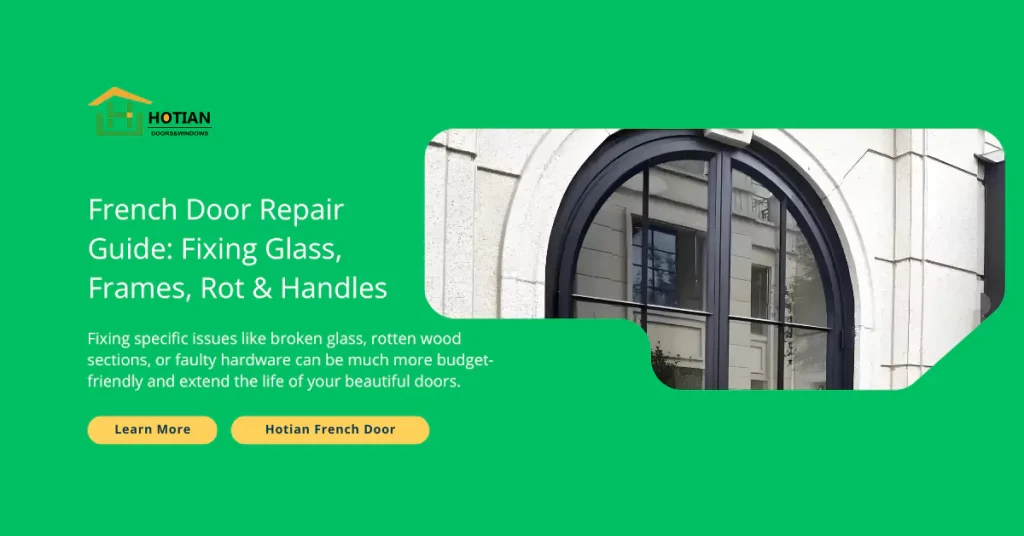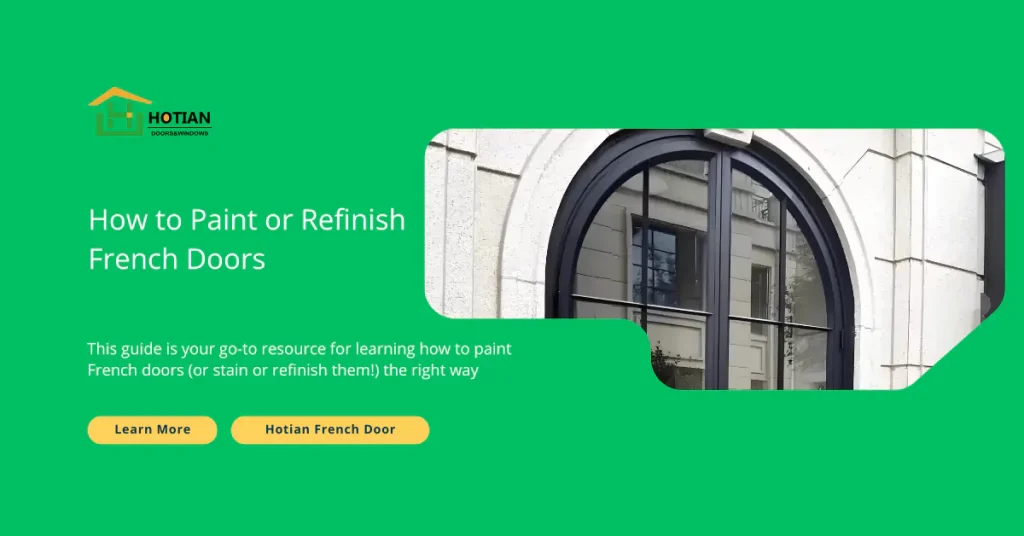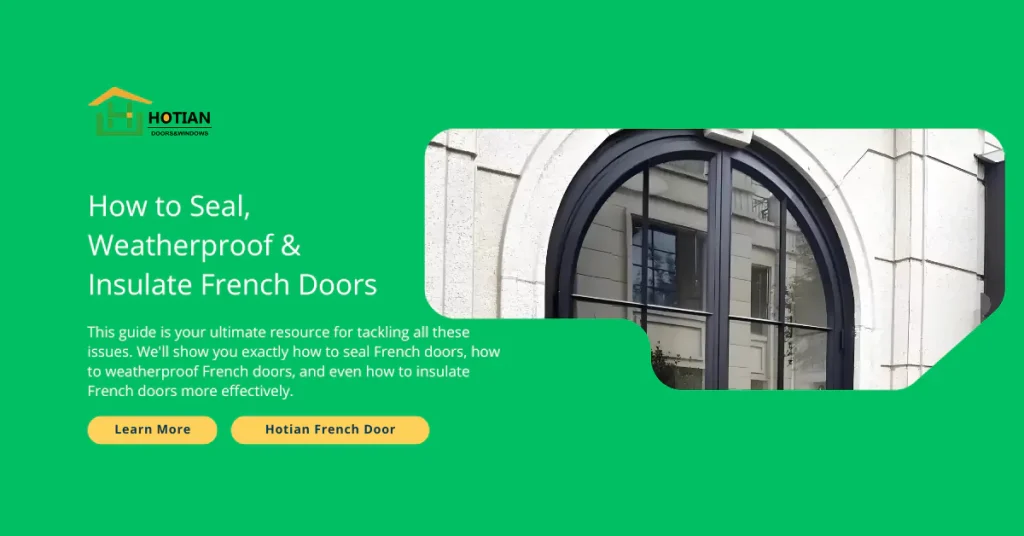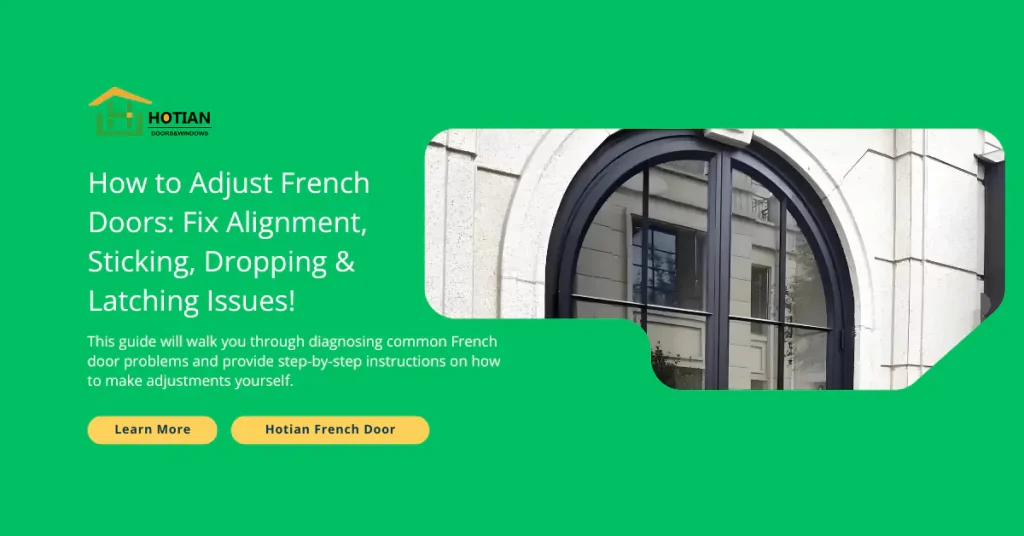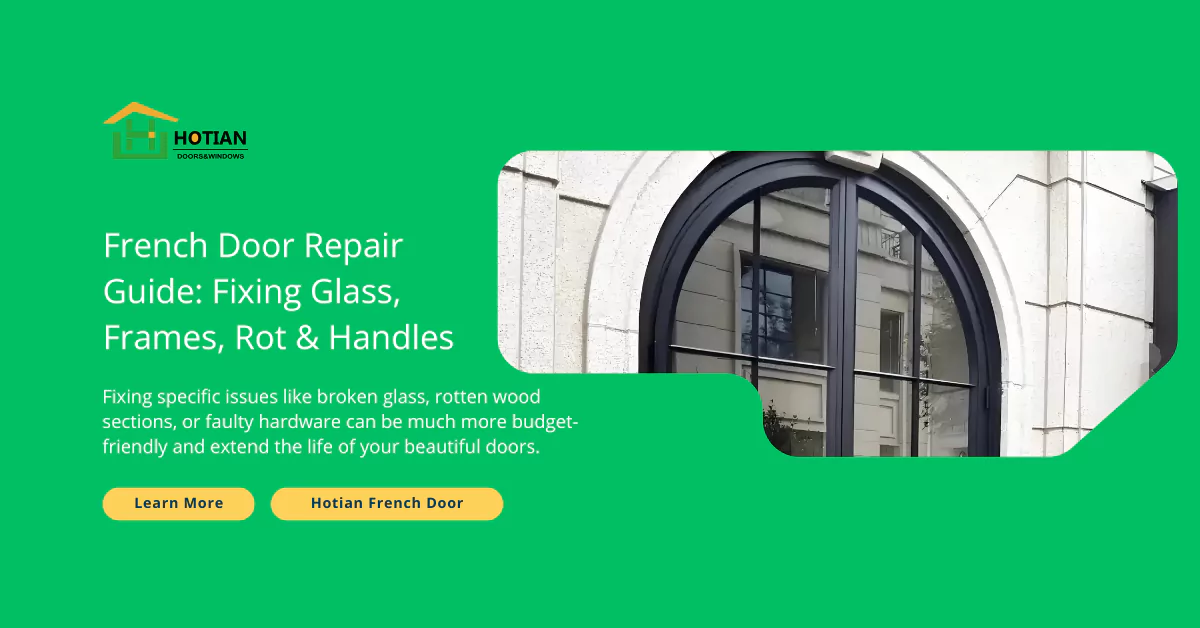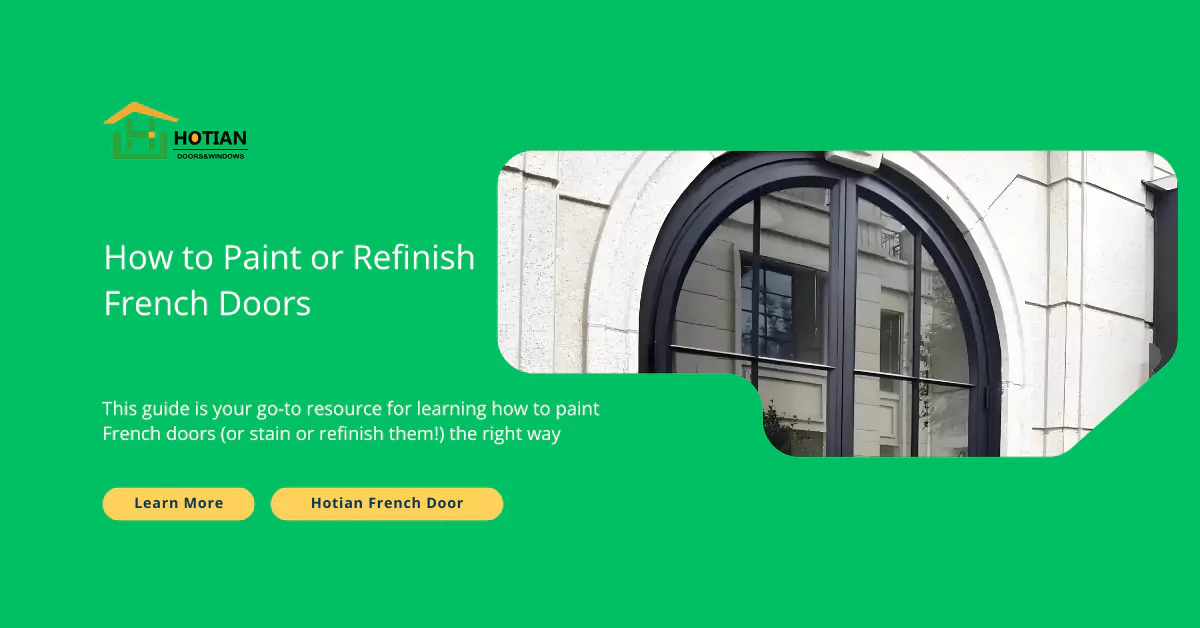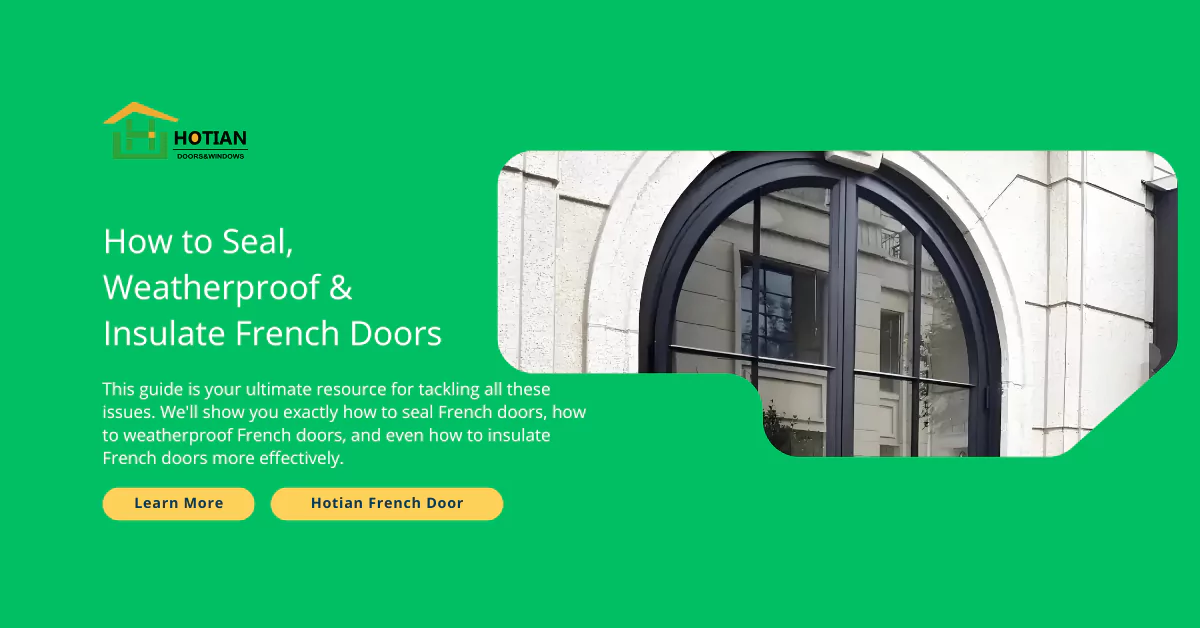French doors! They’re elegant, they let in tons of light, and they can connect your indoor and outdoor spaces beautifully. It’s easy to see why people love them. Want a refresher on the basics? Check out What Are French Doors?.
But when you decide to get French doors, choosing the right ones involves more than just picking a style you like. You need to think about two crucial things:
- The Material: What is the door itself made of (Wood, fiberglass, steel, etc.)? This impacts how long it lasts, how much care it needs, how well it insulates, how secure it is, and of course, how it looks!
- The Hardware: The handles, locks, hinges, and bolts that make the door function. Good hardware is essential for smooth operation, security, and completing the door’s look.
Thinking about what is the best material for exterior French doors? Or wondering what kind of hardware does a French door need? You’re in the right place! Making smart choices about materials and hardware ensures your doors are not just pretty, but also durable, secure, energy-efficient, and a good long-term value for your home.
This guide will break down everything you need to know about French door materials and the essential hardware that goes with them. Let’s get started!
Understanding French Door Basics: The Parts and Pieces
Before we compare materials like fiberglass vs. steel, let’s quickly define the key parts so we’re all speaking the same language:
- Panels/Slabs: The main door sections, typically in pairs for French doors, mostly filled with glass panes (called “lites”).
- Stiles: The vertical pieces forming the sides of each door panel.
- Rails: The horizontal pieces at the top, bottom, and sometimes middle of each door panel.
- Mullions/Grids: Thin strips (wood, vinyl, metal) that divide the glass into smaller panes (lites). Can be true divided lites (separate panes) or grids placed over/between larger glass sheets for looks.
- Jambs: The vertical sides and top piece of the frame that surrounds the door panels in the wall opening.
- Threshold (Sill): The bottom part of the frame you step over (mainly on exterior doors).
- Astragal: A vertical strip attached to the edge of one door panel (the “inactive” one) that covers the gap between the two doors when they’re closed. Often houses the flush bolts.
- Hardware: The functional bits – hinges, handles, locks, bolts.
Why it matters: The material used for the stiles, rails, and core affects the door’s weight, insulation value (R-value), resistance to weather, and maintenance needs. The hardware needs to be strong enough to support the door’s weight, secure enough to keep intruders out (especially important for exterior doors!), and durable enough for daily use.
Comprehensive Material Analysis for French Doors: Pros & Cons Unpacked
Okay, let’s dig into the most common materials used for French doors. Each has its strengths and weaknesses!
| Material | FiberglassAll-Rounder | WoodClassic Beauty | Clad WoodHybrid | SteelSecure | VinylBudget | AluminumModern |
|---|---|---|---|---|---|---|
| Cost Level | Mid-High | Mid-Very High | High-Premium | Mid-Range | Most Affordable | Mid-High |
| Price Comparison |
||||||
| Materials Only |
$850–$4,500 Most quality options: $1,000–$3,500 | $300–$7,000+ Softwood/Basic: $300–$2,000 Premium/Custom: $2,000–$7,000+ | $2,500–$5,500 Standard sizes: $2,500–$5,000 Premium brands: up to $5,500 | $700–$3,000 Most double doors in this range | $500–$2,000 Most double doors in this range | $650–$6,000+ Standard: $650–$2,500 Custom/Multi-panel: $3,000–$6,000+ |
| Installed Cost |
$1,300–$5,000 Varies by features, impact rating, brand | $1,300–$5,500 Standard exterior Custom/Luxury: $7,000–$15,000 | $3,000–$7,000+ Custom/Large: $10,000–$15,000 | $1,300–$4,000 Standard exterior | $1,000–$3,000 Varies by size and features | $3,000–$7,000+ Entry-level: $3,000+ Custom/Large: $7,000–$15,000 |
| Example Prices |
Standard double: $698–$3,847 Premium/impact-rated: $2,985–$4,808 | Interior double: $349–$399 Exterior mahogany: $1,798–$2,998 | Varies widely by manufacturer and options | Basic double units: $1,975–$3,765 Premium designs: $4,000+ | Varies by size and brand | Varies by size, thermal rating, and design |
| Cost Factors | Glass options, custom sizes, wood-grain finish quality, impact rating | Wood species, customization, finishes, carving details, hardware quality | Cladding material, custom sizing, hardware, glass options | Gauge of steel, finish quality, thermal breaks, glass options | Frame quality, reinforcement, glass type, hardware | Thermal breaks, finish options, size, glass type, custom configurations |
| Secondary Info |
Durability: ★★★★★
Maintenance: ★★★★★ (Very Low)
Best For: Almost any climate, balanced features/price
|
Durability: ★★★★★
Maintenance: ★★★★★ (Highest)
Best For: Interiors, protected exteriors, premium look
|
Durability: ★★★★★
Maintenance: ★★★★★ (Low outside)
Best For: Wood interior beauty with exterior protection
|
Durability: ★★★★★
Maintenance: ★★★★★ (Watch for scratches)
Best For: Security-conscious, durability with value
|
Durability: ★★★★★
Maintenance: ★★★★★ (Very Low)
Best For: Budget projects, rentals, low maintenance
|
Durability: ★★★★★
Maintenance: ★★★★★ (Very Low)
Best For: Modern homes, coastal areas, large glass
|
A. Fiberglass: The Popular All-Rounder
- What it is: Made from a composite material of glass fibers and resin, often with a foam core for insulation. Can have smooth surfaces or realistic wood-grain textures.
- Durability & Lifespan: Excellent! Resists dents, scratches, warping, rotting, and shrinking/swelling with temperature changes. Can last 30+ years.
- Weather/Impact Resistance: Handles rain, sun, and humidity very well. Less prone to impact damage than steel (won’t dent as easily). Impact-rated versions available for storm zones.
- Energy Efficiency: Very good insulator, thanks to the foam core. Helps keep heating/cooling costs down.
- Maintenance: Very low! Usually just needs occasional cleaning. Can be painted if desired (use appropriate paint).
- Style Options: Wide variety of styles, finishes, and wood-grain textures available.
- Cost: Mid-to-high range ($1,300–$5,000). More expensive than vinyl or basic steel, often less than high-end wood.
- Best For: Exterior doors in almost any climate, homeowners wanting durability and low maintenance with good looks. A great balance of features.
- Limitations: Can sometimes be damaged by severe impacts (though less likely than dents in steel). High-end textured fiberglass can be pricey.
- Who makes fiberglass exterior french doors? Many major brands like Therma-Tru, Pella, Andersen, Jeld-Wen, and Masonite offer quality fiberglass options.
B. Wood: The Classic Beauty
- What it is: Made from solid wood. Common types include Pine (affordable, softer), Oak (strong, nice grain), Mahogany (premium, durable, beautiful), Fir (stable).
- Aesthetic Appeal: Unmatched natural beauty, warmth, and classic look. Can be stained to show off grain or painted any color. Highly customizable.
- Durability: Depends heavily on the wood type and maintenance. Hardwoods (Oak, Mahogany) are more durable than softwoods (Pine).
- Weather Resistance: This is wood’s challenge. It naturally absorbs moisture, making it prone to warping, swelling, shrinking, and rotting if not meticulously sealed and maintained, especially in wet or humid climates. Needs protection from direct sun/rain (overhangs help). So, is wood good for exterior French doors? It can be, if you choose a durable species, it’s well-constructed, properly sealed, and you commit to regular maintenance (repainting/resealing every few years). Neglect leads to problems.
- Insulation: Naturally a decent insulator, though less so than foam-core fiberglass or steel doors.
- Maintenance: Highest maintenance material. Requires regular inspection, cleaning, and periodic repainting or resealing to protect from weather and prevent damage.
- Cost: Mid-to-very high range ($1,300–$5,500). Price depends heavily on wood species and complexity.
- Best For: Interior doors where weather isn’t an issue; Exterior doors in dry climates or under significant protective overhangs if homeowner is committed to maintenance; Historic renovations; Achieving a specific high-end look. Which wood is best for French doors? For exterior, rot-resistant species like Mahogany, White Oak, or properly treated Fir/Pine are better choices.
- Limitations: Susceptible to weather damage/rot if not maintained, can warp/swell causing sticking, higher cost, high maintenance needs.
C. Clad Wood: Best of Both Worlds?
- What it is: A wood door on the inside (for warmth and looks) with a protective layer (cladding) of Aluminum, Vinyl, or Fiberglass on the outside.
- Benefits: Get the beauty of wood indoors without the high maintenance hassle outdoors.
- Durability & Weather Resistance: Excellent on the exterior, thanks to the cladding. Protects the wood core from rain, sun, and pests.
- Energy Efficiency: Generally very good, combines wood’s natural insulation with the properties of the cladding material.
- Maintenance: Low maintenance on the exterior (just cleaning the cladding). Interior wood side needs standard wood care (dusting, occasional cleaning).
- Style Flexibility: Wide range of exterior colors (from the cladding) and interior wood finishes/paint options.
- Cost: High-end ($3,000–$7,000+). Typically among the most expensive options.
- Best For: Homeowners wanting the interior look of wood without the exterior maintenance burden, suitable for most climates. Premium new construction and renovations.
- Limitations: High cost. If the cladding seal fails (rare with quality brands), moisture could potentially reach the wood core.
D. Vinyl: The Budget-Friendly Option
- What it is: Made primarily from PVC (polyvinyl chloride). Often has internal chambers for structure and some insulation.
- Durability: Good. Won’t rot, peel, or corrode. Can become brittle in extreme cold over many years. Quality varies – cheaper vinyl can warp or discolor more easily in intense heat/sun.
- Weather Resistance: Excellent resistance to moisture.
- Energy Efficiency: Generally good, especially multi-chambered frames. Often comparable to or slightly better than basic wood.
- Maintenance: Very low! Usually just needs cleaning. Typically cannot be painted effectively (color is integral).
- Style Options: More limited than other materials. Mostly available in white or beige, though other colors and some wood-look finishes are becoming more common. Frames tend to be thicker/bulkier than wood or fiberglass.
- Cost: Most affordable ($1,000–$3,000).
- Best For: Budget-conscious projects, rental properties, areas where low maintenance is key. Who makes a high quality vinyl French exterior door? Look for reputable window/door brands that offer robust frame construction and good warranties, as quality can vary significantly in vinyl.
- Limitations: Limited color/style choices, can look less premium, potential for warping in extreme heat with lower quality products, not easily paintable.
E. Steel: Strength and Security
- What it is: A steel skin (usually 20-26 gauge) over a core of high-density foam insulation, often with a wood or composite frame internally.
- Security Benefits: Very strong and resistant to forced entry. Difficult to kick in or pry open when properly installed with good locks.
- Durability: Very durable, won’t warp or crack. However, the steel skin can dent if hit hard, and scratches can lead to rust if not touched up promptly, especially in coastal or humid areas.
- Weather Resistance: Good moisture resistance if paint finish is maintained. Need to address scratches quickly to prevent rust.
- Energy Efficiency: Excellent insulation due to the foam core. However, steel itself conducts heat/cold, so look for doors with good thermal breaks (barriers within the frame/edges) to prevent temperature transfer.
- Maintenance: Low, primarily cleaning and promptly touching up any scratches in the paint to prevent rust.
- Style Options: Can be smooth or sometimes embossed with wood-grain patterns. Paintable.
- Cost: Mid-range ($1,300–$4,000). Generally more affordable than fiberglass or wood.
- Best For: Security-conscious homeowners, applications where durability and affordability are key. Good for most climates if rust prevention is addressed.
- Limitations: Can dent, prone to rust if scratched deeply, can feel cold/hot to the touch without good thermal breaks.
F. Aluminum: Modern and Sleek
- What it is: Doors made with aluminum frames and panels. Popular for contemporary designs.
- Aesthetics: Offers slim, clean lines allowing for larger glass areas. Modern look. Available in various finishes (anodized, painted).
- Durability: Strong, lightweight, won’t rust like steel. Good for coastal areas.
- Weather Resistance: Excellent moisture resistance.
- Energy Efficiency: Aluminum’s main weakness. It conducts heat/cold very easily. Look for doors with thermal breaks – plastic insulators integrated into the frame to reduce temperature transfer. Without thermal breaks, they are poor insulators.
- Maintenance: Low. Just cleaning. Finish is usually durable.
- Customization: Often used for large, custom door systems.
- Cost: Mid-to-high range ($3,000–$7,000+). Thermally broken versions cost more.
- Best For: Modern or contemporary homes, coastal areas (resists corrosion), large openings where slim frames are desired. Best in moderate climates unless using thermally broken frames.
- Limitations: Poor insulator without thermal breaks, can be more expensive than vinyl or steel.
Comparative Material Analysis: Finding Your Best Match
Okay, that was a lot of detail! Let’s simplify with some direct comparisons.
A. Material Comparison Table: At-a-Glance
| Fiberglass All-Rounder | Wood Classic Beauty | Clad Wood Hybrid | Steel Secure | Vinyl Budget | Aluminum Modern | |
|---|---|---|---|---|---|---|
| Cost |
$1,300–$5,000
|
$1,300–$5,500+
|
$3,000–$7,000+
|
$1,300–$4,000
|
$1,000–$3,000
|
$3,000–$7,000+
|
| Durability |
★★★★★
30+ yrs, resists dents/rot
|
★★★★★
Heavily depends on wood/maintenance
|
★★★★★
Excellent (clad exterior)
|
★★★★★
Very durable (dents/rust if scratched)
|
★★★★★
Good, can get brittle (cold/weather)
|
★★★★★
Strong, won’t rust, lightweight
|
| Weather Resistance |
★★★★★
Excellent moisture & temperature
|
★★★★★
Can warp/swell/rot (needs maintenance)
|
★★★★★
Excellent (protected core)
|
★★★★★
Good if painted (rust if scratched)
|
★★★★★
Moisture resistant
|
★★★★★
Excellent, good for coastal areas
|
| Energy Efficiency |
★★★★★
Very good (foam core)
|
★★★★★
Decent (natural wood)
|
★★★★★
Very good
|
★★★★★
Excellent (needs thermal break)
|
★★★★★
Good (multi-chamber)
|
★★★★★
Poor unless thermally broken
|
| Maintenance |
★★★★★
Very low
|
★★★★★
Highest (reseal/paint)
|
★★★★★
Low outside, some inside
|
★★★★★
Low (touch up scratches)
|
★★★★★
Very low
|
★★★★★
Very low
|
| Style Options |
★★★★★
Many options, including wood-look textures
|
★★★★★
Unmatched, highly customizable
|
★★★★★
Wide range, colors & wood interior
|
★★★★★
Paintable, some wood grain textures
|
★★★★★
Limited, mostly white/beige tones
|
★★★★★
Sleek/modern, various finishes
|
| Best For | Most exteriors, busy homeowners, balanced features | Interiors, dry climates, high-end aesthetic | Wood look inside, low maintenance outside | Security, durability, value | Budget projects, rentals, low maintenance | Modern/coastal homes, large glass areas |
| Limitations | Severe impacts, premium textures can be costly | High maintenance, weather vulnerability | Higher cost, potential seal failure (rare) | Can dent, rust risk if scratched, conducts temperature | Limited style options, quality varies | Poor insulator without thermal breaks |
- Best Overall Value/Performance? Often Fiberglass. Balances cost, durability, low maintenance, and energy efficiency well. Which is better steel or fiberglass French doors? Fiberglass resists dents/rust better and often feels less temperature-conductive, while steel might offer slightly higher security feel and lower cost. Fiberglass is generally preferred by many today.
- Most Beautiful (Classic)? Wood (but high maintenance). Clad Wood offers a compromise.
- Lowest Cost? Vinyl.
- Lowest Maintenance? Vinyl and Fiberglass.
- Best for Security? Steel (but Fiberglass is also very strong). Security depends heavily on locks/frame too!
- Best for Modern Style? Aluminum (slim lines), potentially Fiberglass or Steel.
B. Climate-Specific Recommendations:
- Coastal/Humid: Fiberglass, Vinyl, Aluminum (resist moisture/salt well). Wood needs extreme care. Steel needs vigilant rust prevention.
- Cold Climates: Fiberglass, Vinyl, Clad Wood, Thermally Broken Steel/Aluminum (prioritize insulation – U-factor).
- Hot/Sunny Climates: Fiberglass, Vinyl (lighter colors resist heat buildup better), Clad Wood. Wood needs UV protection. Steel can get hot. Prioritize Low-E glass (low SHGC).
- Variable Climates: Fiberglass is often the most stable and adaptable choice.
C. Home Style Matching Guide:
- Traditional/Colonial/Farmhouse: Wood, Clad Wood, Fiberglass (with wood grain).
- Modern/Contemporary: Aluminum, Steel, Fiberglass (smooth finish), maybe Vinyl.
- Craftsman: Wood, Clad Wood, Fiberglass (wood grain).
D. Budget-Based Recommendations:
- Value ($): Vinyl.
- Mid-Range ($$-$$$): Steel, Standard Fiberglass, Basic Wood (interior).
- Premium ($$$$+): High-end Fiberglass, Clad Wood, Premium Wood species.
E. Maintenance Preference Guide:
- Low Maintenance Wanted: Fiberglass, Vinyl.
- Willing to Do Regular Upkeep: Wood.
- Moderate (touch-ups needed): Steel.
Comprehensive French Door Hardware Guide: The Nuts and Bolts
The hardware isn’t just functional; it impacts security, ease of use, and the door’s overall look! What kind of hardware does a French door need?
A. Essential Hardware Components:
- Handlesets (Handles/Knobs/Levers):
- Active vs. Dummy: The main (“active”) door gets a functional handleset with a latch. The second (“inactive”) door often gets a matching “dummy” handle that doesn’t operate a latch (it’s just for looks/pulling).
- Functions:
- Passage: Simple latch, no lock (common for interior closets/hallways).
- Privacy: Latch with a simple lock (thumb-turn inside, emergency release outside) – what handle do I get for bathroom French doors? Usually a privacy lever/knob.
- Keyed Entry: Latch with a key lock (for exterior doors or secure interior rooms like offices).
- Types: Knobs, Levers (often easier to use, especially for accessibility). Addresses: what door handles for French doors, what kind of door handles/knob/handles…
- Locks:
- Deadbolts: ESSENTIAL for exterior doors. Provides primary security against forced entry. Look for Grade 1 or 2.
- Multi-Point Locking Systems: Highly recommended for exterior French doors. Locks the door into the frame at multiple points (top, middle, bottom) for superior security and often better sealing. See How to Secure French Doors for details.
- Mortise Locks: Older style, where lock mechanism fits into a pocket (mortise) cut into the door edge. Less common now than cylindrical locks (standard deadbolts/handle latches).
- Hinges:
- Types: Butt hinges are standard. Ball-bearing hinges offer smoother operation, good for heavier doors. Security hinges needed for outswing exterior doors (non-removable pins). What type of hinges for French doors? Choose size/weight rating appropriate for your door material/size.
- Material/Finish: Match other hardware (brass, stainless, bronze, nickel). Use exterior-rated hinges outside.
- Bolts (for Inactive Door):
- Flush Bolts: Recessed into the door edge (top and bottom). Slide up/down into frame/floor. Need heavy-duty ones for security.
- Surface Bolts: Mount on the inside face of the door. Simpler, more visible.
- Strike Plates & Latches: Metal plates on the frame where the latch/bolt enter. Latches are part of the handleset mechanism.
B. Selecting the Right Hardware: Function Meets Style
- Function First: Keyed entry + deadbolt (or multi-point lock) for exterior. Privacy for bathrooms/bedrooms. Passage for closets. Secure flush bolts for inactive exterior door.
- Style & Finish: Choose hardware that complements your door material and your home’s decor. Match finishes across handles, hinges, bolts. What kind of door levers hardware for French country decor? Look for finishes like oil-rubbed bronze, antique brass, or pewter, often with curved or decorative lever shapes.
- Material Matters: Solid brass is durable and classic. Stainless steel resists rust (great for exterior/coastal). Zinc alloys are common and affordable.
- Security Level: Match hardware quality to your security needs. Grade 1 deadbolt + multi-point lock = high security.
- Handle Placement: Standard height for handles/knobs is around 36 inches from the floor, but follow manufacturer pre-drilled holes if applicable. Where to place handles on French doors? Centered horizontally on the stile (vertical door piece).
C. Hardware Installation: Quick Tips (See main install guide for full details)
Need to know how to install French door hardware?
- Handlesets/Knobs: Most modern doors have pre-drilled holes. Follow the specific instructions included with your hardware – usually involves inserting the latch, then attaching the handles on both sides with connecting screws. How to install door knobs on French doors or how to install French door handles/knobs is typically straightforward with pre-drilled doors. How to install dummy door knobs? These usually just screw directly onto the door surface.
- Locks: Deadbolts install similarly to handles, requiring aligning the bolt mechanism and securing the cylinders. Multi-point systems are usually factory-installed or require professional retrofitting. How to change locks on French bedroom doors / UPVC doors? Usually involves removing the handle/cylinder retaining screws, swapping the cylinder, and reassembling. Consult lock instructions.
- Hinges: How to install French door hinges? If installing slab doors (advanced!), you need to precisely mark and chisel out mortises (recesses) on both door edge and frame jamb. For pre-hung doors, hinges are already installed.
D. Hardware Maintenance & Repair: Keeping Things Smooth
- Tightening: Handles feel loose? How to tighten door handle on French doors / French door handles? Look for small set screws on the side of the lever/knob base, or screws on the inside handle rose (the round plate against the door). Tighten these gently.
- Fixing: Handle sticking? How to fix a French door handle? Try lubricating the latch mechanism first. Check alignment – is the door sagging causing the latch to bind? See How to Adjust French Doors. If mechanism is broken, replacement might be needed.
- Replacing: Can you change a French door handle / with bolt locks? Yes, usually. How to change a French door knob? Remove screws holding the inside/outside handles together, pull handles off, remove latch, and reverse to install new one. How to replace French door handles/locking handles? Same process. Ensure new hardware fits existing door prep holes (backset, bore hole size).
- Removing: Can you remove a French door handle? Yes. How to get a French door handle off / door knob off? Find the retaining screws (usually visible on the inside handle rose or sometimes hidden by a cover plate that twists/pops off). Remove screws, pull handles apart. For levers, there might be a small spring-loaded detent button to press while pulling the lever off the spindle first. How to remove French door hinges? Support the door’s weight! Either tap out the hinge pins (use nail set and hammer from bottom up) or unscrew the hinge leaves from the jamb/door.
Beyond Materials & Hardware: Integrated Considerations
Choosing materials and hardware isn’t done in a vacuum!
- Glass Options: The type of glass (energy efficient Low-E, decorative, impact-resistant) affects door weight (influencing hinge choice) and overall cost/performance. Need to detect glass insert type? Look for labels/etchings, check manufacturer specs, or notice the reflections (Low-E often has a slight tint).
- Compatibility: Ensure hardware finishes match/complement the door color/material. Heavy wood doors need heavy-duty hinges. Smart lock compatibility might depend on door prep/thickness.
- Installation: Heavier doors (wood, steel, large fiberglass) are harder to handle during installation. Drilling into steel requires different bits than wood. See the main How to Install French Doors Guide.
- Sustainability: Consider recycled content (some steel/aluminum), sustainably harvested wood (FSC certified), or materials with longer lifespans (fiberglass) to reduce environmental impact.
- Accessibility: Lever handles are easier to use than knobs. Lighter materials (vinyl, some fiberglass) might be easier to operate. Ensure threshold height meets accessibility needs if required.
Expert Insights and Real-World Experience
- Designers Often Say: “Don’t treat hardware as an afterthought! It’s the ‘jewelry’ of the door. Choose a style and finish that enhances the overall design.” They might note trends towards matte black or brushed gold finishes.
- Installers Often Say: “Fiberglass doors offer the best balance for most homeowners – easier to install than heavy wood, more durable than vinyl, less prone to dents/rust than steel. And always use long screws for hinges and strike plates!”
- Homeowners Often Say: “I love my wood doors, but keeping up with the painting is a chore.” OR “So glad we went with fiberglass – they look great and I haven’t had to touch them in 5 years.”
Making Your Final Decision & Buying Guide
Feeling overwhelmed? Let’s simplify the choice. How to choose/pick French doors?
- Assess Needs: Exterior or interior? High security needed? Low maintenance priority? Specific style goal? Budget limit? Climate challenges?
- Prioritize: What’s MOST important? Durability? Looks? Cost? Energy savings?
- Narrow Down Materials: Use the comparison table (Section IV) based on your priorities. (e.g., Need low maintenance exterior? Focus on Fiberglass/Vinyl).
- Select Hardware: Choose function (entry/privacy/passage), style/finish, and security level appropriate for the door’s location and material.
- Identify Quality: Who makes the best exterior French doors / best French doors? Look for established brands with good warranties (Therma-Tru, Pella, Andersen, Marvin, Jeld-Wen, etc.). Read reviews. Check construction quality (solid feel, good seals). Our French Door Buyer’s Guide has more brand info.
- Get Quotes: Price shop for your chosen door style/material/hardware combination. Factor in installation costs.
(Imagine a simple flowchart: Start with “Exterior or Interior?”, then branch based on “Budget?”, “Maintenance Preference?”, “Style?” leading to recommended material/hardware combos.)
Questions to Ask Suppliers: What’s the warranty (door, finish, glass seal, hardware)? What’s the required rough opening? Is hardware included/extra? What are the energy ratings (U-factor/SHGC)?
FAQs About French Door Materials & Hardware
- Q: Best material for exterior French doors?
- A: Fiberglass is often considered the best all-around balance of durability, low maintenance, energy efficiency, style options, and value. Steel is great for security/budget. Wood is beautiful but high maintenance. Vinyl is budget-friendly but less premium.
- Q: Steel vs. Fiberglass French doors recap?
- A: Fiberglass resists dents/rust better, often better insulator feel. Steel is typically stronger against forced entry, potentially lower cost, but can dent/rust if scratched.
- Q: Is wood suitable for exterior use?
- A: Yes, if properly sealed, maintained regularly, and ideally protected by an overhang. Choose durable wood species. Neglect leads to rot/warp.
- Q: What hardware is essential for French doors?
- A: Hinges (appropriate size/rating), Handleset (active door, maybe dummy on inactive), Lock (deadbolt essential for exterior), Flush Bolts (top/bottom of inactive door).
- Q: Can you change/replace handles and locks? How?
- A: Yes, usually. Remove screws holding the two sides of the handle together, remove the latch, then reverse the process. Ensure the new hardware fits existing door prep holes.
- Q: How to install/remove/tighten handles?
- A: Install = Follow product instructions, usually involves screws connecting inner/outer handles. Remove = Find screws (often on inside handle rose) and remove them. Tighten = Find visible screws or hidden set screws and tighten gently.
- Q: Is Fiberglass low maintenance? Does Steel rust easily?
- A: Fiberglass is very low maintenance (cleaning). Steel only rusts if the protective paint is deeply scratched; touch-ups prevent this. Wood requires the most maintenance (painting/sealing).
- Q: Why do French door prices vary so much?
- A: Material is the biggest factor (Wood/Clad Wood > Fiberglass > Steel > Vinyl). Size, glass type (impact glass $$$), hardware quality, and brand reputation also significantly impact cost. See French Door Costs.
- Q: Are steel doors more secure than fiberglass?
- A: Steel is harder to breach physically. However, overall door security depends more on the lock quality, frame reinforcement, and installation than just the door material. A well-locked fiberglass door in a reinforced frame is very secure. See How to Secure French Doors.
Conclusion: The Perfect Pairing
Choosing the right material and hardware for your French doors is about finding the perfect balance for your specific needs. Consider the door’s location (interior vs. exterior), your climate, your budget, your tolerance for maintenance, your security needs, and your desired aesthetic.
- Fiberglass offers a fantastic, low-maintenance, durable, and energy-efficient solution for most situations.
- Wood provides timeless beauty but demands commitment to upkeep.
- Steel delivers strength and security at a good price point but needs rust prevention.
- Vinyl is the go-to for budget-friendly, low-maintenance needs.
- Hardware should be chosen for appropriate function (security level, privacy), durability (especially exterior), and style coordination. Don’t forget essentials like deadbolts and strong flush bolts!
By carefully considering both the door’s body (material) and its working parts (hardware), you can select French doors that are not only beautiful but also practical, secure, and enjoyable for years to come.
Ready to find French doors with the right material and hardware for you? Explore our wide variety of high-quality, customizable French doors. We offer options in different materials and can help you select the perfect hardware to match. Let’s build your ideal door!

